Carbon Trading: Prices and Taxes Assignment Example | Topics and Well Written Essays - 250 words. https://studentshare.org/finance-accounting/1746216-carbon-trading-assignment
Carbon Trading: Prices and Taxes Assignment Example | Topics and Well Written Essays - 250 Words. https://studentshare.org/finance-accounting/1746216-carbon-trading-assignment.


